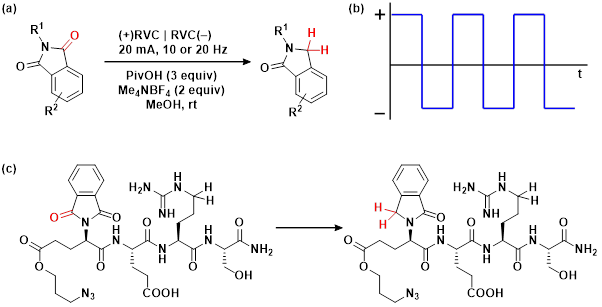During the past few years the application of electrochemical methods for organic synthesis attracted increasing attention both in academia and industry.1 Electroorganic synthesis rely on interaction of the starting materials with electrodes in an electrochemical cell to realize redox chemistry. As inert an inexpensive substances, such as water, can be used as electron donor and acceptors, electrochemical methods are regarded as cost efficient, safe and sustainable.2 Furthermore, as reactive intermediates can be generated under mild conditions, electroorganic synthesis is considered as an enabling technology.
A vast majority of electrochemical synthetic methods utilize direct current (DC) to electrolyze the reaction mixture. Examples of the use of alternating current (AC) are rare. However, the recent resurgence of electroorganic synthesis has also spiked the curiosity of researchers for this unconventional electrolysis mode.3 In particular, the possibility of performing oxidation/reduction sequences on the surface of a single electrode is very attractive as a potential strategy to generate and rapidly transform electrogenerated intermediates, thus increasing the reaction selectivity. Recent examples include trifluoromethylation of arenes4 and the synthesis of Cu–N-heterocyclic carbene complexes.5
A recent report by Baran and coworkers6 describes the chemoselective electrochemical reduction of carbonyl groups in the presence of other redox labile functionalities (Figure 1a). The use of AC with square waveform (Figure 1b) was fundamental to achieve selective carbonyl reduction in same cases. Indeed, DC electrolysis as well as chemical reductants resulted in complex mixtures of products for some of the examples presented. The method was applied to a wide variety of phtalimide derivatives as well as other carbonyl-containing compounds. Notably, selective reduction of the phtalimide carbonyl group of a complex tetrapeptide containing several sensitive functionalities was also achieves in synthetically useful yields.

Figure 1. Chemoselective carbonyl reduction using a square waveform of AC ad application to a complex tetrapeptide.
Parameters such as the AC frequency and the shape of the waveform had a profound impact on the reaction outcome, pointing to a different frequency dependence for each of the competing reactions. These interesting results suggest that new opportunities to enable selective redox chemistry using electrochemical methods could be unlocked in the future using AC.
About the Author:
Dr David Cantillo is an Area Leader at the Research Center Pharmaceutical Engineering Gmbh (RCPE) and in 2018 joined the faculty of University of Graz as Assistant Professor. His current research focuses on synthetic organic electrochemistry. He is a tutor on the course ‘Synthetic Organic Electrochemistry‘ which is an online course taking place July 18th – 20th 2022.
References:
- (a) S. R. Waldvogel, B. Janza, Renaissance of electrosynthetic methods for the construction of complex molecules. Angew. Chem. Int. Ed. 2014, 53, 7122-7123. (b) M. Yan, Y. Kawamata, P. S. Baran, Synthetic Organic Electrochemical Methods since 2000: On the Verge of a Renaissance, Chem. Rev. 2017, 117, 13230-13319. (c) P. G. Echeverria, D. Delbrayelle, A. Letort, F. Nomertin, M. Perez, L. Petit, The Spectacular Resurgence of Electrochemical Redox Reactions in Organic Synthesis. Aldrichimica Acta 2018, 51, 3-19.
- (a) H. J. Schäfer, Contributions of organic electrosynthesis to green chemistry, C. R. Chim. 2011, 14, 745-765. (b) B. A. Frontana-Uribe, R. D. Little, J. G. Ibanez, A. Palma, R. Vasquez-Medrano, Organic electrosynthesis: a promising green methodology in organic chemistry, Green Chem. 2010, 12, 2099-2119.
- S. Rodrigo, D. Gunasekera, J. P. Mahajan, Long Luo Alternating current electrolysis for organic synthesis, Curr. Opin. Electrochem. 2021, 28, 100712.
- S. Rodrigo, C. Um, J. C. Mixdorf, D. Gunasekera, H. M. Nguyen, L. Luo, Alternating current electrolysis for organic electrosynthesis: trifluoromethylation of (hetero)arenes. Org Lett 2020, 22, 6719-6723.
- C. Schotten, C. J. Taylor, R. A. Bourne, T. W. Chamberlain, B. N. Nguyen, N. Kapur, C. E. Willans, Alternating polarity for enhanced electrochemical synthesis. React. Chem. Eng., 2021,6, 147-151.
- Y. Kawamata, K. Hayashi, E. Carlson, S. Shaji, D. Waldmann, B. J. Simmons, J. T. Edwards, C. W. Zapf, M. Saito, P. S. Baran, Chemoselective Electrosynthesis Using Rapid Alternating Polarity, J. Am. Chem. Soc. 2021, 143, 16580-16588.








